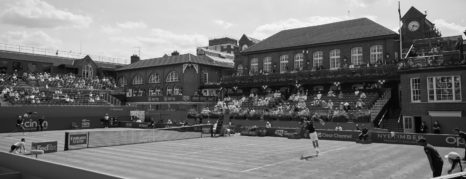Queen’s Tennis Club
The Queen’s Club is home to the ‘pre-Wimbledon’ grass court tennis tournament, known on the circuit simply as ‘Queen’s’.
Many top international players use the tournament as a warm-up for Wimbledon – finding their feet on a grass surface after playing on the red clay of Roland Garros in Paris.
Queen’s is nearly 150 years old and the home of ‘Real Tennis’ in London – the squash-like indoor tennis game famously adored by Henry VIII.
It’s also just around the corner from The Cromwell Hospital. Simon Moyes has enjoyed playing tennis on its pristine courts as a guest, as well as watching some of the world’s best players being put through their paces there, prior to the Grand Slam Wimbledon mayhem.
Watching Italian Matteo Berretini defend his Queens’ title against Filip Krajinovich last weekend was not disappointing. ‘Barratini’s serve was just too strong for Krajinovich, despite a lot of support from the crowd,’ says Simon.

Orthopaedic treatment of tennis injuries
Over the years, Simon has treated many tennis players – both professional and recreational. He has worked alongside some of the world’s best physiotherapists to get the pros back into action and back to work as soon as possible.
Common Tennis Injuries
The injuries most commonly sustained in tennis are fairly universal, says Simon. Relentless training and acute injuries can lead to more severe conditions in the professionals, but many of Simon’s patients suffer from similar problems – as much to do with ageing and not following a sustained programme of warming up, stretching and regular activity.
Here’s a handful of the tennis injuries treated by Simon Moyes and the Capital Orthopaedics team:
Torn Rotator Cuff
The tube of tendons and muscles in your shoulder joint (rotator cuff) stabilises and activates your shoulder. The tendons can get torn as a result of serving and overhead hits in tennis, or get damaged in a fall on the shoulder or on an outstretched arm. Symptoms include pain and reduced range of movement.
Treatment: diagnosis of rotator cuff tear involves a physical test and an MRI scan. Treatment usually involves rest, followed by physical therapy to build up muscles and improve mobility. Steroid injections may be used to reduce inflammation and improve movement. Some partially or completely torn tendons will require arthroscopic surgical repair.
Sprained Ankles
Ankle sprains are usually caused by a twisting or rolling of the ankle and are very common in tennis. Symptoms include: swelling, bruising, instability and pain.
Treatment: mild sprains can be treated at home with rest and ice. However, a sprain can lead to problems like ankle instability and osteoarthritis.
If you have ongoing symptoms, MRI is the most accurate way to diagnose the damage. Most sprains can be treated with physiotherapy. If there is a complete ligament rupture, damage to bone or cartilage or fractures, surgery may be needed.
Tennis Elbow
The tendons that attach your forearm muscles to your elbow joint can become inflamed as a result of overuse. This leads to pain in the outside of your elbow and can cause swelling and reduced range of movement.
Treatment: rest and anti-inflammatories, followed by physiotherapy to help build up the muscles around your elbow joint and improvement of technique to reduce risk of re-injury.
Achilles Tendon Rupture
The thick Achilles tendon attaches your calf muscle to the back of your ankle. It is often torn through explosive movements from a standing start. A complete rupture can feel as though you have been kicked in the back of the leg, with immediate weakness and pain.
Treatment: any sudden pain in your Achilles tendon should be diagnosed as soon as possible. A partial rupture can usually be treated with rest, physiotherapy and massage. Injection therapy can also help stimulate healing in the tendon. A complete rupture almost always requires surgery to reconstruct the tendon.
Patellar Tendonitis
The tendon that connects your shin bone (tibia) to your kneecap (patella) can get inflamed as a result of overuse. Patellar tendonitis can lead to pain in front of your knee or underneath the kneecap, and swelling around the knee.
Treatment: tendonitis is caused by tiny tears in the tendon. They can usually heal with a period of rest, ice and anti inflammatories followed by physical therapy. It is important to get a proper diagnosis, as knee pain can be caused by various conditions requiring different treatments.
Back injuries
The twisting action and repetitive strain of playing tennis can lead to back injuries including: muscle strain, herniated discs, stress fractures and arthritis.
Treatment: any back pain should be carefully diagnosed before starting treatment. Many back injuries can be effectively treated with physiotherapy, particularly with an early diagnosis. If needed, surgery is carried out by our highly experienced orthopaedic surgeons using minimally invasive techniques.
How Capital Orthopaedics Can Help Treat Your Tennis Injuries
If you have any tennis-related injury that is preventing you from playing or affecting your game, contact our team of consultant orthopaedic surgeons and sports medicine experts here.
